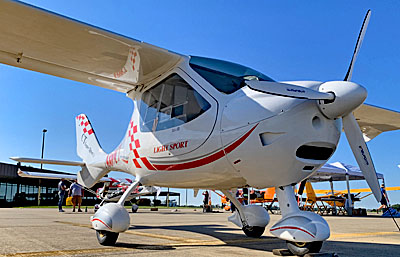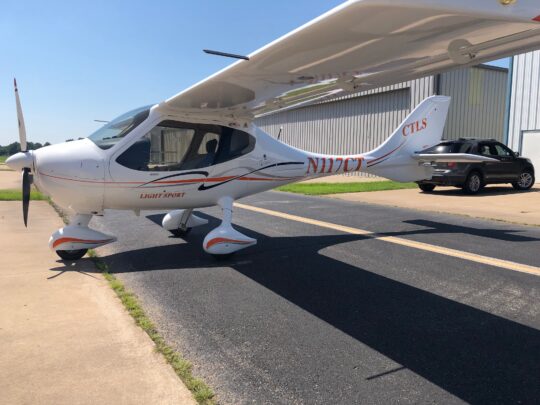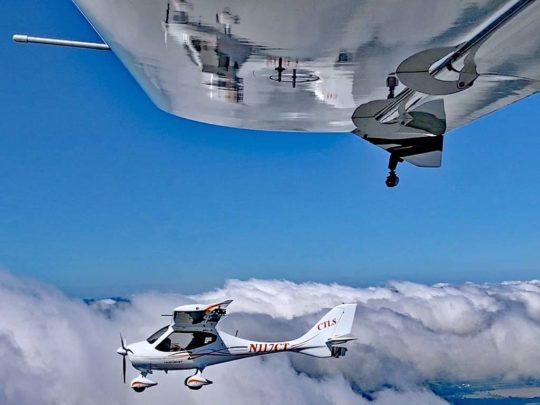 If you’ve ever shopped for a used sport plane you’ve probably noticed there are almost always a number of Flight Design CT series LSAs up for sale. This shouldn’t be surprising since Flight Design was an early player in our segment of aviation, and in the past two-plus decades the company has sold more than 400 CTs in the U.S. alone.
If you’ve ever shopped for a used sport plane you’ve probably noticed there are almost always a number of Flight Design CT series LSAs up for sale. This shouldn’t be surprising since Flight Design was an early player in our segment of aviation, and in the past two-plus decades the company has sold more than 400 CTs in the U.S. alone.
The planes have proven popular, in part, due to their speed (for an LSA), having a cabin wider than a Cessna 172 and their generous payloads. This article is an introduction to the various CT models, their flight characteristics, and advice for a pre-buy inspection and ownership.
Development
The first CT was produced in Germany by a company that began with hang gliders and paragliders in the 1980s and ultralights in the early 1990s. Now part of LIFT Air Gmbh, Flight Design has faced financial woes over the years, having gone into receivership, and then challenges caused by the war in Ukraine where the aircraft were being built. Money is less of an issue now and production is being done in the Czech Republic. There is a completely different company making the CTLS in China for that country’s market only, according to Tom Gutman, Jr., who imports CTs into the U.S..
 There have been a number of CT models/variants over the years. The original CT flew in 1996 and was superseded by the CT2K in 2000. But as Dan Johnson has reported, it was the CTSW ”short wing” developed just after that helped Flight Design become an LSA market leader. While the CTSW proved popular, it had its critics. Flight Design responded by introducing the CTLS in 2008 to make the plane a little more forgiving and to introduce other improvements.
There have been a number of CT models/variants over the years. The original CT flew in 1996 and was superseded by the CT2K in 2000. But as Dan Johnson has reported, it was the CTSW ”short wing” developed just after that helped Flight Design become an LSA market leader. While the CTSW proved popular, it had its critics. Flight Design responded by introducing the CTLS in 2008 to make the plane a little more forgiving and to introduce other improvements.
Around the same time, the company produced a slightly heavier and slower all-metal version for flight training, the CTMC (metal concept), and the CTLS-Lite, a lighter and reduced feature/budget model CT. Quick to follow were the CTLE, a version for law enforcement featuring a wing mounted camera, the fuel injected Rotax 912iS powered CTLSi, the CT Supralight for the European ultralight market, and the CTLS GT with a Rotax 914.
If you’re thinking that it’s going to be difficult to decide which model to buy, stop. The odds are good your choice will be limited to either a CTSW or CTLS since these models were made in the greatest numbers. This article will focus on them exclusively.
Features & Flight Characteristics
Specifications for these two CTs and the other models vary. (You can easily find them online.) You can generally expect an empty weight between 700 & 800 pounds, a stall speed between 35 and 40 knots, cruise speeds between 115 and 130 knots and a fuel capacity of 34 gallons. The CTSW is lighter and faster than the IS, but has a higher stall speed. Many models come with a ballistic parachute system. Avionics vary, with older planes sporting round gauges and later models featuring glass. Almost all of the used CTs available will have a Rotax 912ULS.

All CTs feature composite bodies, a blessing or a curse depending upon your viewpoint. (More on this later.) Flight Design uses a carbon fiber-foam-carbon fiber and Kevlar laminate over Rohacell foam for the wings and tail, and over Airex foam for the fuselage core. The LS model introduced composite landing gear.

One advantage of the LS model is its composite landing gear, which helps soak up less than perfect landings. Another possible advantage of the LS over the SW is its slightly longer length and greater wingspan, which reportedly offer better longitudinal stability. “The LS is less squirrely than the SW at lower speeds next to the ground,” contends CFI Helen Woods, owner of Chesapeake Sport Pilot, a Maryland flight school and maintenance center that has considerable experience with Flight Design’s planes.
Review owner comments on the internet and you’ll find that all CTs require solid stick and rudder skills. The planes demand attention to maintain coordinated flight, especially the shorter winged SW. Some critics say the SW is a little too difficult to fly, but others are up for the challenge in return for increased speed and payload.
“It’s possible to teach someone to fly the SW safely,” says Woods, “but it does take specific training and pilots need to fly frequently to remain proficient.” (Those who buy new planes from Flight Design in the U.S. are required to take transition training, according to Gutman.)
Pre-purchase Inspection

“We’ve seen a lot of bent landing gear and bent rudder pedals,” said Ripley when asked about CTs and rough landings. “And the composite bodies need to be inspected for delamination, especially if the plane’s been kept outside.”
“Always check the tail area for water,” warns Lagno. “It can collect inside there and cause corrosion which can freeze the controls or, in the winter, split the composite.”
The engines on CTs should also be gone over by someone familiar with Rotaxes. As an early player in Light Sport, CTs were among the first LSAs many A&Ps ever worked on. Woods says some weren’t as knowledgeable about Rotaxes as they should have been. “Look for specific Rotax maintenance things in the logbook—like rubber replacement and carb floats,” she suggests. “And see if all of the service bulletins have been followed.” (There have been relatively few SBs considering nearly 30 years of production.)
Maintenance & Ownership
Owners seem to be very happy with the reliability of their planes, noting easy access to parts and excellent support from Flight Design in the U.S. Some CTs have logged more than 5000 hours, according to the company.

The sleekness of the design made possible by composite construction, however, can occasionally make CTs a little more difficult to work on. The engine’s in a tight space, and getting to the starter, for example, isn’t as straightforward as on conventionally constructed aircraft, notes Ripley.
Peghiny says “once mastered, they are fast and really a hoot to fly.” Guttmann, who owns a CTSW, says their cabins and payload capabilities put them way ahead of other Light Sport planes. “Both my father and I are 300 pounds and 6-foot-5. There’s nothing else we can both get into and fly as comfortably,” he said.
Woods highly recommends flying any CT you’re thinking of buying before writing the check. “Be sure you’re happy with what you’re getting into,” she advises.


You should note the problem I’m having with finding a good Rotax mechanic in your area. My CTLS has been down for over 2 months as part of issues after the 5 year rubber replacement. Can’t fly it. Can’t find any hands on help.